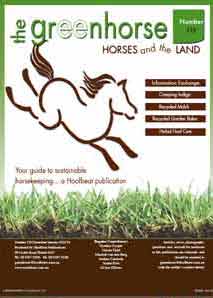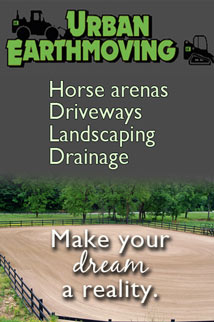The Green Horse section provides practical information on managing environmentally sustainable horse properties, readers stories and tips, as well as advice and articles from equestrian experts in their fields.
October/November 2019
Vol 41 No 3
In this issue of The Green Horse you will find the following articles:
TERMITES – common myths
by Rhiannon Brown
Your house and stables are looking wonderful this spring, but do you know what is happening inside the walls of your brick or timber building?
BUZZ OFF ! by Wendy Elks
It’s fly season, so what can you do to make your horse more comfortable?
YOUR PLACE: High View
by Kristy Hawkes
Located 5 minutes west of Warrnambool in Western Victoria, High View Horse Complex lies between a volcano and a vast ocean vista. The horses here not only have a great view, but benefit from the natural grazing systems of Jaime Jackson (Paddock Paradise) and Jane Myers (Equiculture).
‘READING’ YOUR HORSE'S MANURE
by Antoinette Foster
What does manure tell you about the state of your horse’s health?
SIZE MATTERS - selecting a wheelbarrow by Andie Wyatt
Around the stable few items are handier than a wheelbarrow.It’s such a humble item that it’s easy to take a wheelbarrow for granted. But go without, or buy the wrong model, and the inconvenience becomes apparent.
GARLIC - one little bulb, so much to consider by Catherine Bird for County Park Herbs
Garlic does have a place in assisting horses with their health and wellbeing, however there is a need for an awareness of its volatility and there are times to avoid using it.
WIN A YEAR'S SUBSCRIPTION...
share your equine property management tips and each issue one reader will win.
Send ideas to -
The Green Horse Support <greenhorse@hoofbeats.com.au>


PREVIOUS ARTICLES
Available on line
AS19 - OUCH THAT HURTS
by Catherine Bird for Country Park Saddlery
The extent of the swelling is usually an indication of the severity of the infection or injury and the cause needs to be established before giving herbs.
JJ19 - MANAGING PASTURE
by Rhiannon Brown, Envirapest Healthy pasture means healthy horses.
A/M19 - STOP THOSE WEEDS
Property biosecurity
by Rhiannon Brown, Envirapest
Putting simple precautionary steps into place can make it tough for weeds to get a hold on your equine paradise.
|
  
  

TERMITES - common myths
Your house and stables are looking wonderful this spring, but do you know what is happening inside the walls of your brick or timber building?
by Rhiannon Brown - Envirapest
Protecting your home and stable from termites is one of things that people tend to set aside in their minds – until it is too late.
In our business, we find that people who care about termite protection are the ones who have had a bad experience in the past. Whether you have a small duplex in the city or a sprawling acreage everyone around Australia is at risk of termite damage (except Tasmania).
Doing termite research is really not something most people have time for in their busy lives of working and maintaining their equestrian lifestyle, so we are going to run through some of the myths about termites in Australia
.
MYTH – “If I have a termite infestation then my home insurance will cover me.”
NOT TRUE - There are very few (if any) insurance policies that will cover you for termite damage. There are a few products on the market you can purchase specifically for termite damage – like TimberSecure - but these are completely separate policies that you can purchase in addition to your home insurance. We have had many clients who thought they have been covered for damage when in fact they were not – and then they had to find the money to fix the damage the termites had done.
MYTH – “I have termites eating a tree down the back. I am leaving them alone because it is better that they have something to eat, rather than the house or stable.”
NOT TRUE - Again, this one is a BIG old wives’ tale. When you have termites in close proximity to buildings (whether it is a fence post, in the old stables or in a tree) they are happily building up a bigger and better colony. These colonies need a lot of food to survive so are constantly sending out foragers to find more food. Then when they find the house the colony you have been feeding down the back is ready to attack your home – fast.
You really don’t want to have any termites around your property at all and having them treated by a professional will decrease the population.
MYTH – “My house and stables are brick and tile or have steel frames so I am not at risk.”
NOT TRUE - Termites don’t discriminate. In fact, 80% of our termite work is done in brick and tile homes! Termites will come through tiny cracks in the concrete slab and work their way up gyprock paper backing, through plumbing pipes, cracks in bricks and find a way in. They will eat anything with cellulose. We have even found them eating a paper sticker on the back of a floor mat at a front door!
It isn’t all doom and gloom though!
There are a few things you can do that will dramatically minimise your chance of termite attack and put you in the best position moving forward.
1 : Termites LOVE moisture. They hunt it out. If you have downpipes on your house or stable running straight onto the ground, or a leaking hose or hot water system next to the building – then prepare to attract termites. Make sure your taps and retic aren’t leaking and all of your downpipes run into soak wells.
2: Think about your landscaping. Having garden beds up against the house or stable walls is a huge attractant for termites, you are basically giving them easy access through the soil – straight to the weepholes of the house. Even though railway sleepers may look beautiful as a garden feature – they might not look so great once the termites eat them.
3: Check your storage. If you have items stored in cardboard boxes in your sheds or stables make sure they are up off the ground and not against the walls. Better yet – spend the money on some cheap plastic tubs from Bunnings!
4: Have a termite inspection every year. We cannot stress this enough. You really should be engaging a professional, licenced and insured pest controller to come and inspect your property and surrounds. Pest technicians are trained to conduct these inspections, highlight high risk areas and provide protection solutions.
Every home and stable is different and termite management is not a ‘one-size-fits-all’ situation. A good inspection should cost between $250 - $350 and take about an hour or two. You will receive a thorough report that should include photos. Think about this cost as a necessary expense – like you do with your insurance, and budget for it each year. This inspection gives your property the best sort of protection and will pick up termite activity in its earliest stage, which can save you thousands in the long run. |